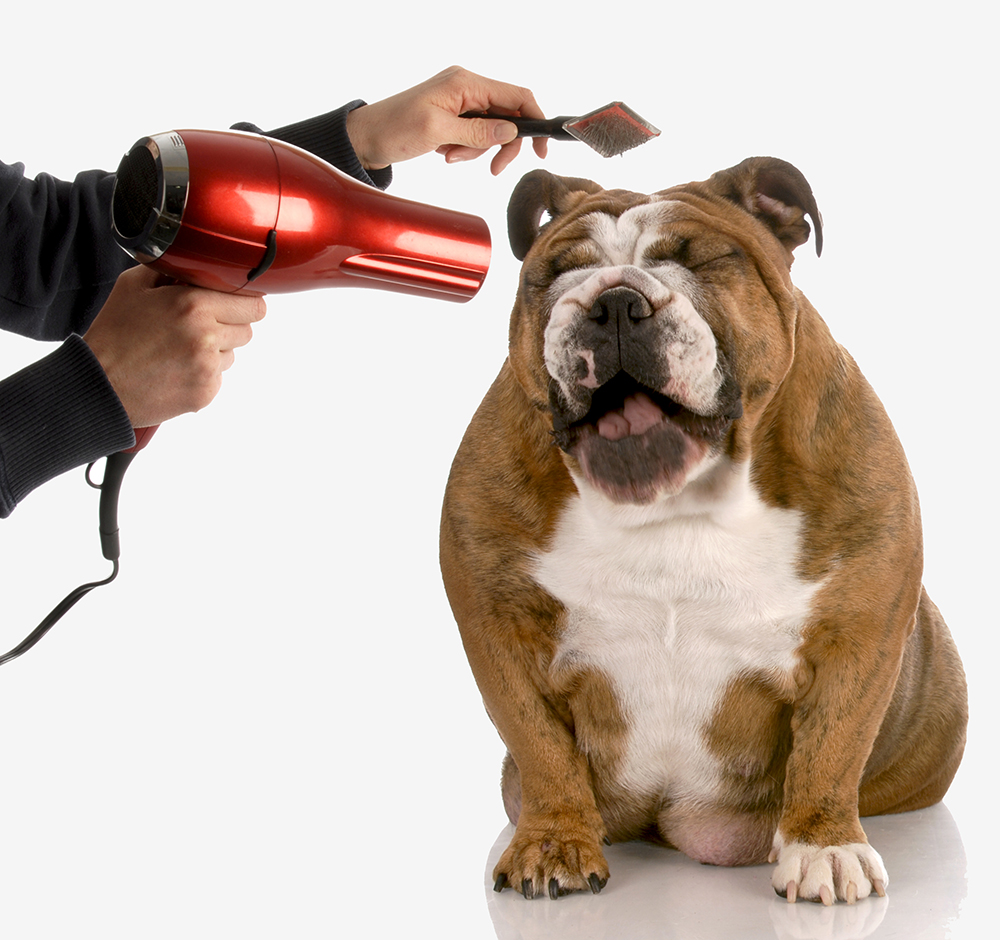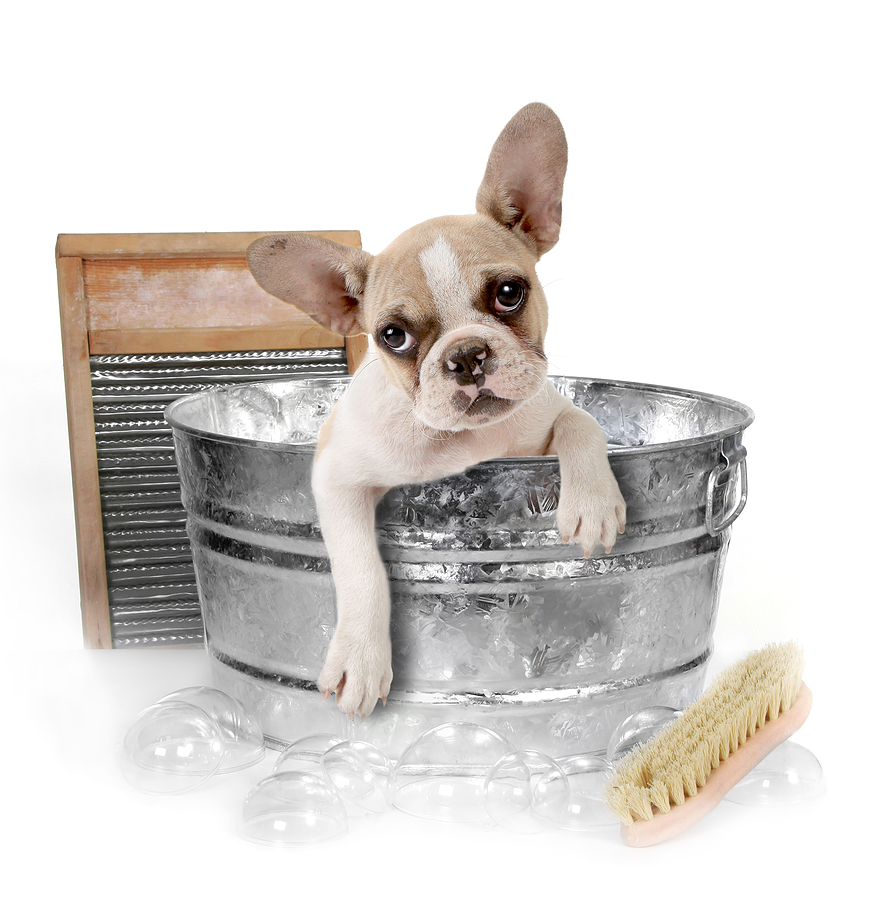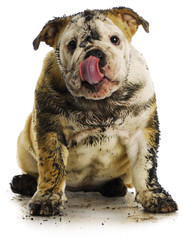Easy At-Home Grooming Techniques from the Pros
Posted by Nicole Thompson - Owner, Paws 2 Purrfection, LLC on 6th Oct 2017
Scrub-A-Dub-Dub, Put that Pooch in the Tub!
Grooming your dog doesn't have to cost a fortune or even be difficult!
Check out these must know DIY tricks & tips from professional groomers
to learn how you can do it yourself right at home!

You know you always feel better when you've just had a bath/shower and so does your dog. Without frequent (expensive) trips to the groomer, your dog's skin can become dirty, itchy and irritated and they can begin to become a little less enjoyable to be around, as the lanolin in their skin starts to give off that "stinky-dog" smell. Dog grooming can be low cost and easy when you follow these simple tricks & tips to tend to your dog right at home.
Before the bath…
I would say the most difficult part of at home grooming is probably going to be convincing your dog that they want to hop into the tub…
Some pups just plain don't wanna!
It may help to have a fun game of catch or a tussle on the floor before bath time to "set the mood" so to speak. But if this doesn't help, I've found it may require just a good, old fashion scoop and delivery method. Arguably more difficult, the larger the dog, of course.
Prepare yourself with patience and a lot of extra towels too. This will make after bath clean up a lot easier.
Groomer's Tip #1 - Pre-Bath Prep
One of the key techniques to getting a good, clean pup with a smooth coat, is to pre-brush before getting them into the tub. Dog's with medium to long coats may have some mats that should be brushed out ahead of time. This will keep the fur from snarling further when wet and helps to eliminate having to cut them away afterwards. Dog's with shorter coats can be brushed with a grooming glove which will help draw out dead hair and dirt from the skin, making it easier to wash away and get a good clean pooch when finished.
Dog's with a very thick coat may require using an undercoat rake to help pull out the dead hair and make it easier to shampoo and rinse, once bathing has commenced.

Groomer's Tip #2 - Into the Tub
A common mistake is filling the tup with water during bath time. Your dog will literally be wading around in dirty water, which will not only make it harder to wash them, but it can cause bacteria to linger on the lower legs and pads of the feet, if not properly rinsed. Instead, use a hose attachment for wetting and rinsing your dog. Some shower heads come with a secondary wand that can be brought right down to your dog's level, making it much easier to bathe them. The hose can also make it much easier to rinse those hard to reach areas like the buns & tummy. But if you don't have a hose attachment, a clean cup with fresh water will do the trick.

Groomer's Tip #3 - Suds O'Clock
Shampooing your dog can be both fun & frustrating. Getting them all lathered up and giving them a full body scrub down just HAS to feel AMAZING! However using too much shampoo can be a bit of a nightmare when it's time to rinse. Begin shampooing at the top and work your way down. You'll want to begin at the neck and head by using some diluted shampoo. This will not only make it easier to rinse, but actually distributes over your dog easier too. Use caution around the eyes, nose, ears & mouth. Even when a shampoo says it's gentle to the eyes, it's not a great idea to just let it go on in. You'll also want to use care in rinsing these areas. Most dogs aren't predisposed to underwater activities, so they may get a little nervous when water is either poured or sprayed near their face. You'll know you have rinsed your dog throughly when the water runs clear.


Groomer's Tip #4 - Towel Time
Place a towel on the floor or table where you are going to be drying your dog off to prevent slipping and also to help with excess water. You'll want to towel your dog off as much as possible. For dogs with a shorter coat, this isn't too difficult and they can mostly just air dry. You will want to have a towel that's easy to maneuver and can fit over most of your dog. Dogs with longer and/or thicker coats can be mostly towel dried and then a blow dryer can be used, if they will tolerate the sound. Be sure to keep the setting on the dryer on LOW and don't hold it too close to your dog to avoid burning them. Blow dry until damp and then let them air dry the rest of the way to avoid drying out their skin.

Groomer's Tip #5 - Have you heard?
Ears are notorious little crevasses for growing nasty yeast infections, which can be very common in dogs. Regular ear care & maintenance is important. When you rinse your dog, try to avoid pouring or spraying water in their ears and be sure to dry them gently but thoroughly. You can also flush the ears about once a week with an ear cleaning solution that contains a drying agent to help prevent excess moisture from accumulating in the ears.
Warm, moist places tend it breed these infections, so regular ear care is important. During summer months, you may want to do this once or twice a week and it should always be done after swimming.
If you notice your dog shaking their head a lot or scratching at their ears. This could be a sign of an ear infection. Other signs are a strong smell coming from the ears, redness or puffy swelled areas in and around the ear. You will also want to be more vigilant with dogs that have a history of ear infections. If you notice any of these symptoms, do not hesitate to contact your veterinarian for follow up care.

Groomer's Tip #6 - SMILE!!
PEEEEE-UUUU! Nothing much worse than dog breath… Pups need regular dental care just like people. They don't eat sugary sweets or chew bubble gum, but they can get plaque and tartar build up too! Regularly brushing your dog's chompers can not only help alleviate bad breath, but it can help prevent dental disease which can, in turn, lead to more serious health issues down the road if not maintained.
Your dog may not be too keen on having you brush their teeth, but if you begin doing it from their very first bath, they will eventually come to expect it each time. DO NOT USE HUMAN TOOTHPASTE! There are ingredients in human toothpaste that can be toxic to dogs. You can use a veterinary toothpaste or you can make your own from natural ingredients. (recipe below)
Basic Doggie Toothpaste Recipe:
- 2 Tbsp baking soda
- 2 Tbsp coconut oil
- 1 Drop peppermint oil (optional)
You can use a soft toothbrush or a clean cloth to brush your dog's teeth. Apply a small amount of the toothpaste to the cleaning device of choice and gently, but thoroughly massage the whole mouth, being careful to try to make sure every tooth gets a little attention. The first time you do this may not be too successful and give your dog breaks in between before trying to do the whole mouth. Eventually, you'll get it all done and they will have fresh breath in no time!

Groomer's Tip #7 - Mani-Pedi Time!
At home nail trimming is not as scary as you might believe. Check out our detailed how-to's in our recent blog post!
How to Safely Trim Your Pets Nails at Home
With a little practice, patience and consistency, you'll be a pro at doggie bath time, bringing you and your fuzzy buddy closer than ever and they'll be smellin' like a rose!
Below are some our top picks for at home dog grooming!
|
1 Vet Anti-fungal Dog Shampoo |
Pet King Zymox for Pet Ears |
Paws & Pals Dog Enzymatic Toothpaste |
FURminator Long Hair deShedding Tool |
Paws 2 Purrfection, LLC is a participant in the Amazon Services LLC Associates Program, an affiliate advertising program designed to provide a means for sites to earn advertising fees by advertising and linking to amazon.com



